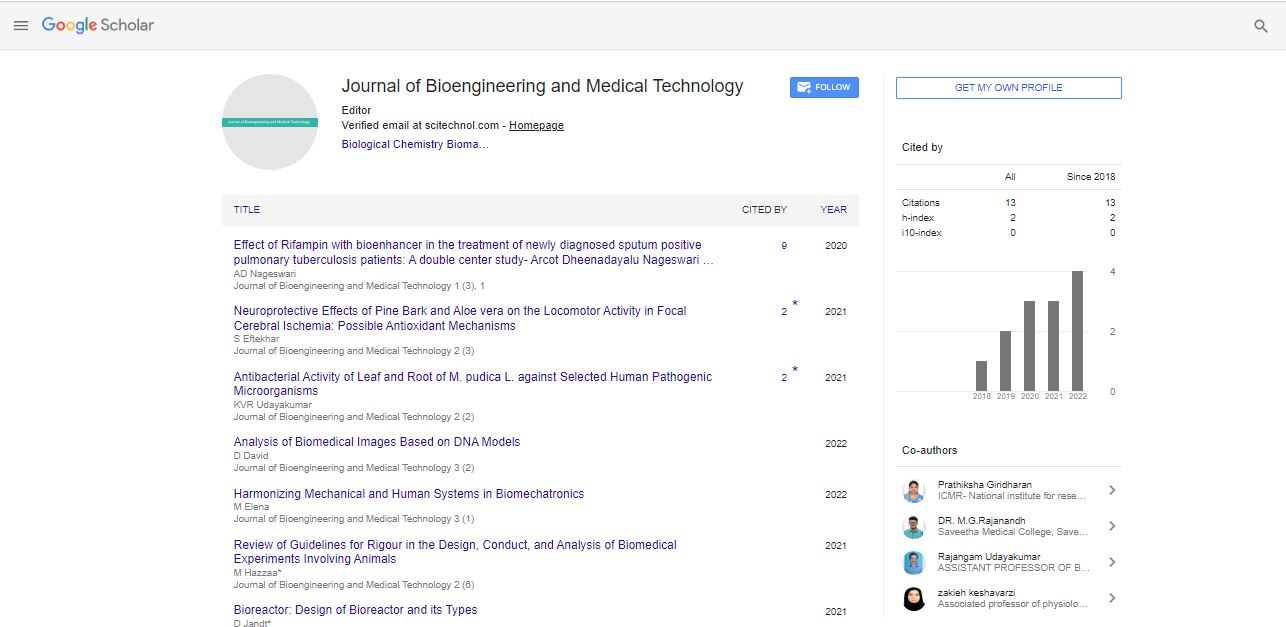Perspective, J Bioeng Med Technol Vol: 4 Issue: 1
Enhancing Fetal Well-Being with CTG Monitoring
Harry Gasper*
1Department of Medicine, Royal Brisbane Hospital, Queensland, Australia.
*Corresponding Author: Harry Gasper
Department of Medicine, Royal Brisbane
Hospital, Queensland, Australia
E-mail: gasperh@gmail.com
Received date: 22 February, 2023, Manuscript No. JBMT-23-93287;
Editor assigned date: 27 February, 2023, Pre QC No. JBMT-23-93287(PQ);
Reviewed date: 14 March, 2023, QC No. JBMT-23-93287;
Revised date: 21 March, 2023, Manuscript No: JBMT-23-93287(R);
Published date: 28 March, 2023, DOI: 10.35248/jbmt.1000071
Citation: Gasper H (2023) Enhancing Fetal Well-Being with CTG Monitoring. J Bioeng Med Technol 4:1.
Description
Cardiotocography (CTG) monitoring is a non-invasive procedure used to assess fetal well-being during pregnancy and labor. The procedure involves measuring the fetal heart rate and uterine contractions using an ultrasound transducer and a tocodynamometer, respectively. CTG monitoring can provide valuable information about the health and well-being of the fetus, helping healthcare providers make timely and informed decisions about the management of pregnancy and labor. One of the primary goals of CTG monitoring is to identify fetal distress, which can occur when the fetus is not receiving enough oxygen. Fetal distress can lead to serious complications such as fetal hypoxia, acidosis, and even fetal death. CTG monitoring can detect early signs of fetal distress, allowing healthcare providers to intervene before the situation becomes critical. CTG monitoring can be performed both antepartum and intrapartum. Antepartum CTG monitoring is usually done in high-risk pregnancies to monitor fetal well-being and to determine the optimal timing and mode of delivery. Intrapartum CTG monitoring is done during labor to assess fetal wellbeing and to detect any signs of fetal distress that may require intervention. CTG monitoring can provide valuable information about the fetal heart rate pattern. The fetal heart rate should be regular and within a normal range. Fetal heart rate variability is an important indicator of fetal well-being. Reduced variability can be a sign of fetal distress. In addition, changes in the fetal heart rate pattern, such as decelerations, can also indicate fetal distress. CTG monitoring can also provide information about uterine contractions. The frequency, duration, and strength of contractions can be measured using a tocodynamometer. Excessive uterine contractions can reduce blood flow to the placenta, leading to fetal distress. CTG monitoring can help healthcare providers identify abnormal uterine contractions and take appropriate action to prevent fetal distress.CTG monitoring is an important tool for enhancing fetal well-being during pregnancy and labor. However, the interpretation of CTG tracings requires expertise and experience. Healthcare providers must be trained to recognize abnormal fetal heart rate patterns and uterine contractions and to take appropriate action when necessary. In addition to CTG monitoring, other measures can be taken to enhance fetal well-being during pregnancy and labor. These include optimizing maternal health, monitoring fetal growth and development, and providing appropriate prenatal care. During labor, measures such as maintaining adequate hydration, providing pain relief, and avoiding unnecessary interventions can also help promote fetal well-being.
In conclusion, CTG monitoring is a valuable tool for enhancing fetal well-being during pregnancy and labor. It can provide valuable information about the fetal heart rate pattern and uterine contractions, helping healthcare providers identify signs of fetal distress and take appropriate action. CTG monitoring, along with other measures, can help promote a safe and healthy pregnancy and delivery, and ensure the best possible outcome for both mother and baby.
CTG is based on the principle that the fetal heart rate changes in response to fetal well-being and oxygen supply. The fetal heart rate is measured using an ultrasound transducer placed over the fetal heart.The uterine contractions are measured using a tocodynamometer, which is placed over the mother's abdomen. CTG can be performed both antepartum and intrapartum, but the procedure and interpretation differ in each case. CTG is interpreted based on the pattern of the fetal heart rate and uterine contractions. There are three types of fetal heart rate patterns: Category I, Category II, and Category III. Category I represents a normal fetal heart rate pattern, while Category III represents abnormal fetal heart rate patterns that require urgent intervention. In general, regular contractions that last for at least 30 seconds and occur every 2-3 minutes are considered normal. However, in some cases, the contractions may be too strong or too frequent, which can lead to fetal distress. CTG is a valuable tool for managing fetal distress. It is an essential tool for monitoring fetal wellbeing during pregnancy and labor. It is a non-invasive procedure that measures the fetal heart rate and uterine contractions. CTG is used to identify fetal distress and determine the need for intervention, such as delivery or further monitoring. The interpretation of CTG is based on the pattern of the fetal heart rate and uterine contractions. By understanding the principles of CTG, its interpretation, and its role in managing fetal distress, healthcare professionals can ensure the best possible outcomes for mothers and their babies.
 Spanish
Spanish  Chinese
Chinese  Russian
Russian  German
German  French
French  Japanese
Japanese  Portuguese
Portuguese  Hindi
Hindi 
